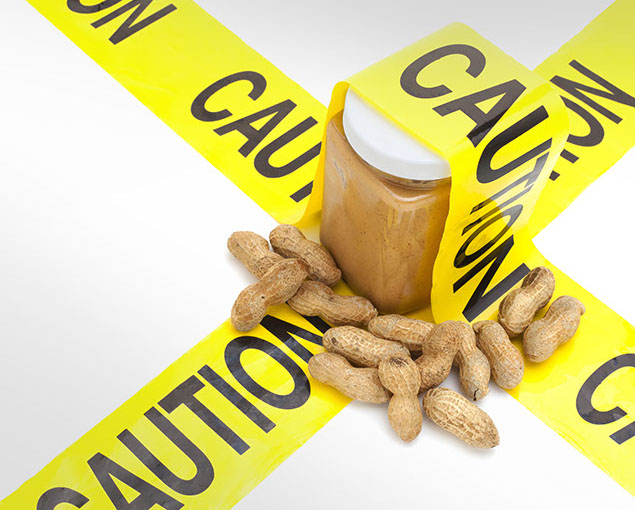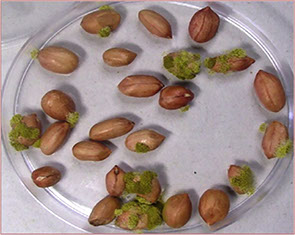The Low-Lifes
In Our Food

Microscopic toxins in food can wreak all sorts of havoc with health. Dr Hani El-Nezami’s laboratory has been sleuthing them out.

Cereals, nuts and oils are essential to our health but when they get mouldy they can also harbour aflatoxins, a particularly nasty class of compounds that have been shown conclusively to cause liver damage and cancer. Research at HKU has shown just how persistent and difficult aflatoxins can be.
The Food Safety and Toxicology Laboratory headed by Dr Hani El-Nezami investigates food contaminant exposure in at-risk populations, the effects on the placenta, the interactive effects of different toxins, and gut microbiota that may help or hinder health.
With the aflatoxin case, he was curious as to why young people in certain populations – particularly those with a high prevalence of hepatitis B – were developing liver cancer as early as 20.
It was already known that aflatoxins and hepatitis B interacted to multiply the odds of developing liver cancer from three to seven per cent for each singly, to 60 per cent when combined. But it still usually takes decades to develop liver cancer. Could these young people have been exposed in the womb?
Focussing on China and Egypt, and working in collaboration with partners in Finland, he found this to indeed be the case.
“We found that aflatoxins can cross the placenta and be detected in the foetus. We also found aflatoxin present in breast milk. So those who developed liver cancer at age 20 were exposed in utero, in the breast milk and of course in normal life. The insult on the liver was very high in the end,” he said.

![]() There is a misconception that everything natural is safe and anything synthetic is dangerous to health. If you fail to use the pesticides or fungicides, you can have mould and it will stay in the food – the toxin can be very difficult to get rid of.
There is a misconception that everything natural is safe and anything synthetic is dangerous to health. If you fail to use the pesticides or fungicides, you can have mould and it will stay in the food – the toxin can be very difficult to get rid of. ![]()
Dr Hani El-Nezami
Detox concerns
Dr El-Nezami similarly was asked to investigate the placental crossover of melamine, after the Department of Health commissioned him to do a study in the wake of the contaminated milk powder scandal in China. He found it accumulated in the placental tissue but did not cross over to the foetus. “But this was a short-term study. It would be more realistic to look at one or two generations to be sure exposure of the foetus to melamine did not lead to disease development later in life,” he said.
He and his team also study other potential contaminants such as nanosilver, an anti-microbial agent applied to many products including baby bottles. So far it has not been found to cross into the placenta but only long-term monitoring will confirm that there are no ill effects.
“Many natural toxins have the ability to cross into the placenta,” he said. “Our adult detoxification system is much more mature compared to a child’s. We can withstand insults to our liver or gut, but a child cannot. That’s why it is very important in terms of child health to look at additives like food colouring and food additives, and whether they cross into the placenta.”

Nuts can also harbour aflatoxins which can cause liver damage if they get mouldy.
The emphasis on natural toxins is important because the most toxic compounds are from natural sources.
“There is a misconception that everything natural is safe and anything synthetic is dangerous to health. If you fail to use the pesticides or fungicides, you can have mould and it will stay in the food – the toxin can be very difficult to get rid of. If you don’t have adequate monitoring of the microbial population in organic food, then you are at higher risk of getting microbial contamination than when you use pesticides,” he said.
Toxic cocktails
Natural toxins can have damaging effects on adults, too, quite apart from placental crossover. Dr El-Nezami’s laboratory has been investigating whether cocktails of toxins in the diet – even when each toxin is of a negligible quantity – can cause enough cumulative damage to contribute to leaky gut syndrome, which has been linked to metabolic conditions such as diabetes, obesity and artherosclerosis.
“Regulators tend to regulate single compounds, but our big message to them is that it is not enough to say that being exposed to five micrograms per kilo of a certain toxin will not cause a health problem. There are other toxins present, too, so even one microgram of that toxin could have a deleterious health impact when it is combined with the others.”
Dr El-Nezami’s team is also looking for solutions. Working with probiotics, they have identified a bacteria that can block the absorption of aflatoxins in the gut. The discovery was donated to the Food and Agriculture Organization of the United Nations for use in developing countries.
They have also recently filed for a US patent for a bacteria concoction they developed that can suffocate cancerous tumours of the liver – a sideline, he said, to the ultimate goal of protecting gut health by tackling it from the unusual perspective of food safety.

If food additives cross into the placenta, children will easily be attacked as they have weaker detoxification system than adults.

